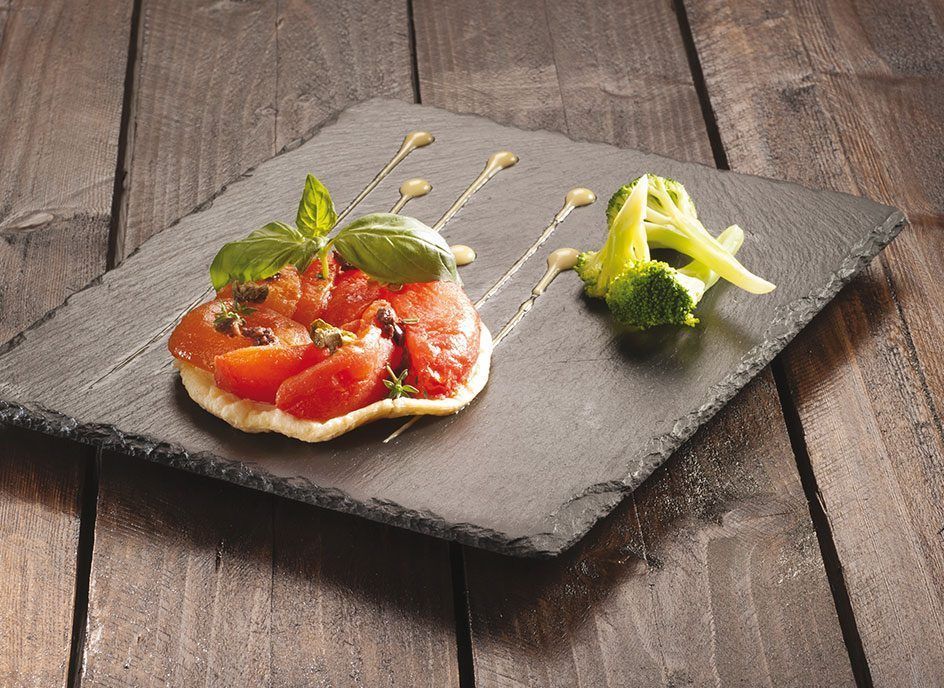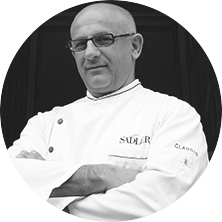
Appetizer, Main course
Vine-ripened tomato & mozzarella tatin.

4
people

15 min
(cooking time)

25 min
(total time)

Difficulty
Easy
Ingredients
Instructions
Roll out puff pastry dough to 5 mm thick and, using a glass, cut out 10 disks of about 8 cm diam. Refrigerate. Parboil the vine-ripened tomatoes, peel and cut outside pulp in cloves, saving the insides for the tomato water. Take individual baking molds (8 cm round) and place wax paper inside each one, add salt and pepper, moisten with half of the evo garlic oil, sprinkle with powdered sugar and add the tomato cloves. Flavor with thyme and add bufala mozzarella (making sure it is drained of its liquid and diced first). Cover with disks of puff pastry dough and place in a pre-heated oven at 180°C for 15 mins. Once cooked, remove from oven and flip tray over, removing wax paper from the top.
Clean the broccoli rabe, shape them nicely, then cook and let cool, seasoning with salt, pepper and half of the evo garlic oil.
For the evo oil tomato water emulsion: In a blender, mix the tomato pulp set aside from the Tatin preparation and strain into a bowl, lining the strainer with a paper towel as a filter (it will take a few hours for the liquid to drain through completely). In a blender, add egg whites, ‘Dolce Fruttato’ oil, white vinegar, salt, pepper and soy lecithin.
Recover tomato water and pour in blender. Beat well and strain.
Composition: Place the Tatin on a plate, pour the tomato water emulsion and evo oil around it, decorate with a few broccoli florets, a little olive paté with some evo oil to add shine, and finally, garnish each Tatin with a small clump of basil, a few leaves of thyme and a couple of dried capers.
Clean the broccoli rabe, shape them nicely, then cook and let cool, seasoning with salt, pepper and half of the evo garlic oil.
For the evo oil tomato water emulsion: In a blender, mix the tomato pulp set aside from the Tatin preparation and strain into a bowl, lining the strainer with a paper towel as a filter (it will take a few hours for the liquid to drain through completely). In a blender, add egg whites, ‘Dolce Fruttato’ oil, white vinegar, salt, pepper and soy lecithin.
Recover tomato water and pour in blender. Beat well and strain.
Composition: Place the Tatin on a plate, pour the tomato water emulsion and evo oil around it, decorate with a few broccoli florets, a little olive paté with some evo oil to add shine, and finally, garnish each Tatin with a small clump of basil, a few leaves of thyme and a couple of dried capers.

LO CHEF: CLAUDIO SADLER
“Evolving modern cuisine”: this is probably the definition that best describes his cooking philosophy. Milanese by birth and in spirit, born in 1956, Claudio Sadler is now an internationally recognised chef, awarded no less than 2 Michelin Stars.
In his recipes he is always looking for harmony, simplicity and delicacy, in a careful balance between faithfulness to the traditions of regional Italian cooking and reinterpretations enhanced by a very personal creativity and artistic sensibility. This is made possible thanks to an approach which is at the same time methodical and open to innovation, based on sound skills and a strict application of rules.
The process for developing a new Claudio Sadler dish is long and complex: often months are needed before a dish becomes part of the chef’s menu. But once there, each new creation shows off a small masterpiece in taste and presentation.
In his recipes he is always looking for harmony, simplicity and delicacy, in a careful balance between faithfulness to the traditions of regional Italian cooking and reinterpretations enhanced by a very personal creativity and artistic sensibility. This is made possible thanks to an approach which is at the same time methodical and open to innovation, based on sound skills and a strict application of rules.
The process for developing a new Claudio Sadler dish is long and complex: often months are needed before a dish becomes part of the chef’s menu. But once there, each new creation shows off a small masterpiece in taste and presentation.
